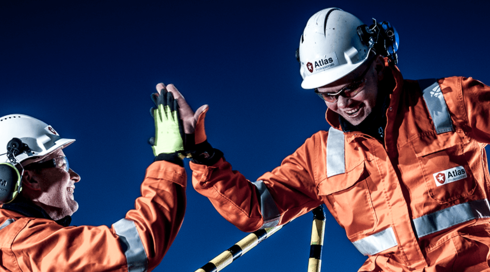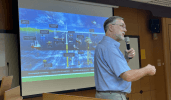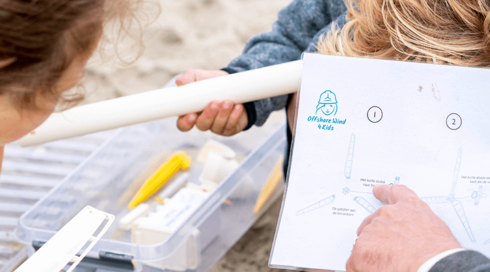2
He is one of Belgium’s C-level specialists in renewables: Mathias Verkest, who helped form the country’s offshore landscape from the start of the pioneering C-Power windfarm and is looking forward to completing the SeaMade windfarm in 2020. “The stress is really on being efficient in all phases of the project and having the windfarm up and running as soon as possible. The margin for errors has disappeared.”
We are all in the same boat, says Mathias Verkest, interviewed by Atlas Professionals via Teams. It is the end of April and almost all countries in Europe are in lock-down. Yet, the construction plan for the SeaMade wind farm is still on track. “The foundations, substations and export cables are installed. The in-field cables are being installed and the installation of the turbines is still expected to commence in June, in line with the original schedule.” That, he admits, is already quite an achievement. “But of course, it’s a constant stress. Is the supply chain managing constraints well? We need to count on the experience of our contractors, which have been chosen wisely. We hope that they can continue overcoming issues as we are overcoming them, from day to day.”
With its 65 staff members and 10 years of experience working on offshore wind projects, the team at the full-cycle independent developer Otary can take a hit. For the staff, working from home is not the only challenge. “We also had to do quite dramatic things to keep the yard operational, for instance by reducing people on the workboat (and hence increasing workboats and helicopter access), but also dealing with social distancing rules and ensuring that people are comfortable in going offshore. We are doing the utmost to get the people and specialists into Belgium. It all leads to additional difficulties and costs, but at least it all keeps on going and that’s the good thing.”
Otary is not only working on the construction of SeaMade, but also operates the Rentel offshore wind farm that consists of 42 7.35MW turbines. Due to the current situation, they are encountering additional operational hurdles, but these are being managed. “Having access to a well-functioning and organised team of professionals, with a complimentary set of competences and abilities, certainly is a big advantage in these times. All turbines are operational; the wind farm is producing. Apart from a decrease in electricity demand and output restrictions from time to time, everything is going quite smoothly. But of course, we feel the impact, of course we are affected and this will cost us something, but who’s not affected these days.”
Future proof
At the time of writing, Belgium has quite strict coronavirus containment measures in place and sees many sectors halted. Currently, SeaMade is the largest infrastructure project in progress in the country. This probably demonstrates that the sector is a mature industry, according to Verkest: “Whilst a lot of sectors are halted, offshore wind is needed more than ever. Not only from a societal and environmental point of view because it’s clean energy, but also because at the core it’s still energy production. That is a basic need for society.”
SeaMade is also a wind farm in Belgium with a government backed levelized cost of energy. Looking to the future, Verkest is ambitious but realistic as a CEO of Otary. “Doing more for less money and still innovate, that’s of course a challenge. In Belgium a price driven tender system may be applied. We are skilled and we are in any event ambitious to participate in that tender round if the parameters are right as Belgium has a quite complex energy landscape whereby strategic choices need to be made on electricity generation of tomorrow and a nuclear exit. Even beyond that, we are on the outlook for future new ventures. I think we can bring added value to either small developers that are still sitting on a concession and want to move ahead, but also probably bigger players to whom we can offer immediate hands-on experience.”
Increased efficiency
SeaMade originally consisted of two separate projects of about 300 MW each. The decision to merge SeaStar and Mermaid was based on creating economies of scale and efficiency. “It didn’t make sense to organise the financing but also the construction activities in two separate movements as we were confident of doing it at once. The supply chain was also asking for a more scalable size as well, to be more competitive in operations and maintenance as well as in construction,” says Verkest.
“Everything needs to happen sooner, faster and better now that the market is maturing. Everything needs to get done more efficiently and more economically. And that’s where we have a lot of knowhow,” he continues when being asked about human capital challenges in the industry. “We are not a new kid on the block. We have done more than one project and managed to keep an experienced team together. That was clearly our intention and nowadays a big asset.”
The power of a team
Verkest agrees that finding competent and qualified professionals and getting them to the right locations remains cumbersome even in normal circumstances. “That’s always the challenge because a developer is typically chasing on projects. You either win or lose but when you get it, you need to have a team promptly. In addition, the development timings and scheduled take over dates are becoming more and more challenging, sometimes ignoring less controllable parameters such as grid access, regulatory constraints, or other follow-up projects and supply chain constrains. The stress (and the value) is really on being efficient and having it up and running as soon as possible.”
So, access to good professionals alone is not enough: “As we face demand for more efficiency you need both; good people that function well with each other and are acting as a team.” With SeaMade expected to produce power from mid-2020 onwards Verkest hopes to celebrate that achievement en masse with the entire team. “It’s still an unbelievable project and it takes a tremendous effort to bring all pieces of the puzzle together and to get it operational. We will share our excitement with a lot of people; stakeholders, professionals working on it but also external parties, which contributed to make such a project succeed. We’ll be very excited,” he says with a big smile on his face.
Full circle
Starting his career as a lawyer it wasn’t an obvious route to where he is today. “Offshore wind suddenly drew my attention and I was quite excited about it. At the time, I did not imagine the size it would ultimately get to. It was a matter of belief but above all, just diving into it. It’s still like that today – the industry has matured and professionalised dramatically, but you just need to get into it and experience it. Of course, the nice thing is that offshore wind has grown exponentially and I got the chance to grow with the industry. But also vice versa, having worked on different Belgian offshore wind projects, I could put my shoulders to the wheel at a sector level. This gave me to opportunity to help the sector grow in one of the pioneering countries. Professionals from many sectors (engineering, finance, legal, construction etc) have joined the offshore wind industry over the past few years with great enthusiasm. That interplay has been quite cool.”
Verkest and his team are now completing the last piece of the puzzle. “In Belgium we’ll have nearly 400 wind turbines in the North Sea, and we still are 4th in terms of installed capacity. That’s amazing for the small piece of North Sea we have. The potential in other countries is so much bigger and now it will go faster. For example, in the Netherlands they have many areas that will now open for offshore wind. But the 2200 MW installed in Belgium over the last 10 years, that’s quite something.” Verkest had the opportunity to be involved in the first one and now in the last one of the first round so that is also a full circle for him. Let’s hope the team can raise the glass in person when SeaMade is operational!
Are you curious about working in renewables? Check renewables.atlasprofessionals.com for opportunities in onshore and offshore wind across the globe. For the Netherlands, visit www.werkenindewind.nl and for Belgium see www.werkenindewind.be.
.png)
.png)


